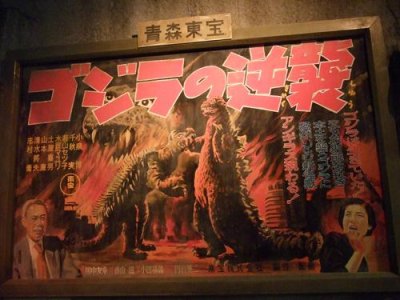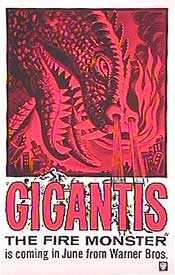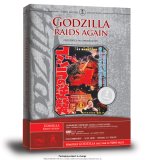| Reviews & Columns |
|
Reviews DVD TV on DVD Blu-ray 4K UHD International DVDs In Theaters Reviews by Studio Video Games Features Collector Series DVDs Easter Egg Database Interviews DVD Talk Radio Feature Articles Columns Anime Talk DVD Savant Horror DVDs The M.O.D. Squad Art House HD Talk Silent DVD
|
DVD Talk Forum |
|
|
| Resources |
|
DVD Price Search Customer Service #'s RCE Info Links |
|
Columns
|
|
|
Godzilla Raids Again / Gigantis the Fire Monster
Unlike the more familiar Godzilla movies of the 1960s, Godzilla Raids Again eschew the usual line-up of reporters, scientists, and military figures in the main roles and the high-tech weaponry usually associated with the genre. Instead it focuses its narrative on an Osaka-based fishery and the company's two spotting pilots (Hiroshi Koizumi and Minoru Chiaki), who discover a new Godzilla along with another giant monster making his series debut, the spiky-backed quadruped Angilas.
Despite the rushed nature of the production -- it was conceived, scripted, planned, shot, edited and scored, and out in movie theaters across Japan in less than six months after the first Godzilla's premiere -- Special Effects Director Eiji Tsuburaya's miniatures and optical effects are ambitious and elaborate, albeit not done with quite the care and precision of the first film.
The highlight is Godzilla and Angilas' thrashing of Osaka which, in a bad script structuring move, comes halfway through the film. From here the story shifts to Hokkaido where the big climax, in which the Japanese Self-Defense Forces try to bury Godzilla in an avalanche of ice cubes, completely lacks the high-stakes tension of the middle section.
The film was directed by prolific Toho contractee Motoyoshi Oda, making his sole contribution to the giant monster genre. Though a contemporary of Akira Kurosawa, Ishiro Honda, and Senkichi Taniguchi (all studied under highly-regarded mentor Kajiro Yamamoto), Oda's career was pretty much limited to countless B-movie comedies and thrillers produced on the cheap to fill out Toho's package of double-bills.
Nevertheless, Oda's direction is actually pretty good considering how quickly this was made. By contrast Ishiro Honda preferred tableaux, putting a bunch of people together in a frame and then they tend to interact in static medium shots. Oda, conversely, uses a lot more close-ups and has a tendency to begin and sometimes end scenes with a little bit of dollying, tracking in and out of the admittedly pretty sappy melodrama. He inventively uses hand-held cameras in the nightclub scene, which lend the film a documentary-like, you-are-there feeling (and these images of early postwar Japan are by themselves interesting) and this hand-held technique was pretty unusual for a fiction film made by a Japanese studio back then. And his direction of the first unit footage of the Osaka destruction sequence is tightly edited and dynamic.
Unfortunately, the production cuts corners in the set department. Throughout the film characters stand in front of featureless sets and their lack of detail and personality give Oda and his characters little to do but stand around and mope about Godzilla's destruction. The main characters are curiously uninvolving, this despite the fact that Hiroshi Koizumi is an immensely likeable actor, sort of a Japanese Richard Carlson, and Minoru Chiaki was one of the country's best supporting actors, famous for his roles in such films as Seven Samurai (as the woodcutter samurai) and The Hidden Fortress (as the bumbling peasant that served as the model for Star Wars' C-3PO).
If the Japanese version is undone by poor story construction and a general blandness, the American version is such an exasperating hodgepodge that it's best enjoyed as high camp. As Steve Ryfle details in his Audio Commentary Track, the U.S. distributors originally conceived a much more ambitious film to be called "The Volcano Monsters," which was to use most of the spfx footage, shoot some additional effects in America, and build an entirely new story around it set in San Francisco. Instead, producer Paul Schreibman, apparently using former RKO head Howard Hughes as his role model, opted to alter his acquisition with incessant reediting, rescoring, extremely bad dubbing, and added stock footage -- all of which serves only to make the movie look awesomely ridiculous. The most notable addition is its CONSTANT narration (by an uncredited Keye Luke) by Koizumi's character, who yammers endlessly about stuff we already know, events we have already seen or that's onscreen at the moment, or which the audience couldn't care less about.
Video & Audio
Godzilla Raids Again is presented in its original full-frame format, and is a big improvement over previous home video versions, which tended to be printed so dark that at times it was hard to even see the monsters fighting one another. The Japanese version offers English subtitles in rather unattractive yellow font that, on the plus side, is at least easy to read. The original Gigantis the Fire Monster title card as been optically removed in favor of Toho's preferred Godzilla Raids Again moniker via video supering.
There is an encoding glitch on some copies of the DVD at the 1:04 mark in which the image momentarily has combing/interlacing problems. Customers experiencing this problem can get replacement discs here.
Extra Features
The main supplement is an excellent audio commentary by Steve Ryfle "and Friends". Ryfle goes into considerable detail on both films, frequently pointing to the endless absurdities of the English-dubbed version. Some have criticized his jokey attitude but unlike, say, the folks as Mystery Science Theater 3000 or the unendurably smug gag-fests on discs like Naked Pursuit, Ryfle's comments illustrate the English version's ludicrousness in which the film, not Steve, is its own worst enemy, and his comments are buttressed by a mountain of primary research backing up these wry observations. Ed Godziszewski is on hand mainly to discuss and comment on Tsuburaya's special effects scenes while Bob Burns and this reviewer appear briefly to discuss other aspects of the film.**
Also included is the Godziszewski-written and produced Art of Suit Acting, an informative and charming tribute to the men who donned those fiendishly heavy and oxygen-deprived costumes so that Eiji Tsuburaya's crews could shoot missiles and whatnot at them. It's loaded with great, eye-popping stills. Finally, there's a slideshow of Godzilla movie posters and lobby cards from the Japanese release, many quite colorful. Rather surprisingly, there's no trailer for the Japanese version, even though one exists.
Once again, special kudos to Classic Media for their excellent packaging and animated menu screens, which really set the mood.
Parting Thoughts
Godzilla Raids Again had for years been one of the hardest Godzilla pictures to see in America as it all but vanished during the '60s and '70s only to turn up as a bargain VHS release in the early-1980s. It's far from the series' best, but Classic Media's presentation has much to recommend it.
**Ryfle crams so much commentary onto the disc that most of what this reviewer recorded ended up on the cutting room floor. I was especially sorry to hear that my list of director Oda's other credits, mentioned to give the listener a sense of his career, was deleted. For the record what I said was: "He also directed Toho's first part-color movie, 1946's Juichi-nin no jo gakusei, or "11 Schoolgirls," which had Fujicolor sequences. Mostly though he made programmers like A Young Couple Oversleeps, a Kingoro Yanagiya comedy called Stubborn Father and Musical Daughter, a Tony Tani comedy called Family Affairs: They're Stupid, Aren't They?, a thriller called The Virgin with the Scapel, and Employee with the Secret Savings and the Autocrat Company President: The Employee with the Secret Savings Fights Bravely. Try sticking that on a marquee!
Film historian Stuart Galbraith IV's most recent essays appear in Criterion's new three-disc Seven Samurai DVD and BCI Eclipse's The Quiet Duel.
|
| Popular Reviews |
| Sponsored Links |
|
|
| Sponsored Links |
|
|
| Release List | Reviews | Shop | Newsletter | Forum | DVD Giveaways | Blu-Ray | Advertise |
|
Copyright 2024 DVDTalk.com All Rights Reserved. Legal Info, Privacy Policy, Terms of Use,
Manage Preferences,
Your Privacy Choices | |||||||
















